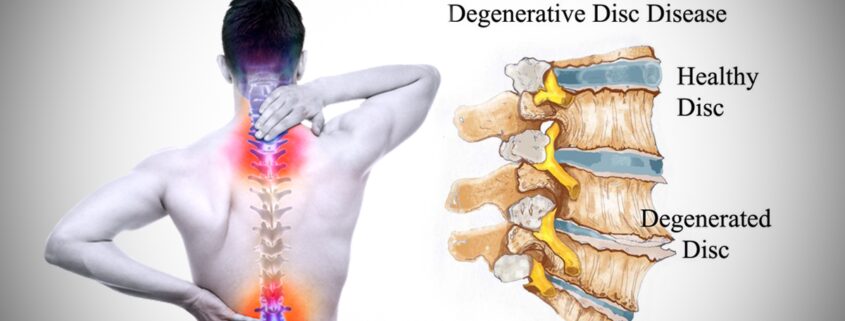Degenerative Disk Disease: Symptoms, Causes, Treatment
What are the symptoms of degenerative disk disease?
Degenerative disc disease (DDD) is a condition that occurs when the intervertebral discs in the spine degenerate or break down, leading to pain and other symptoms. The symptoms of degenerative disc disease can vary depending on the location and severity of the affected discs. Common symptoms include:
- Back or neck pain: The most common symptom of degenerative disc disease is pain in the lower back (lumbar spine) or neck (cervical spine). The pain may be intermittent or constant and can range from mild to severe.
- Pain that worsens with movement: Activities such as bending, lifting, or twisting may exacerbate the pain.
- Pain that improves with rest: Pain from degenerative disc disease may temporarily improve with rest or changes in position.
- Pain that radiates to the arms or legs: If degenerative disc disease affects the cervical spine, it may cause pain that radiates down the arms. If it affects the lumbar spine, it may cause pain that radiates down the legs (sciatica).
- Numbness or tingling: Degenerative disc disease can lead to numbness or tingling in the arms, hands, legs, or feet.
- Weakness: In severe cases, degenerative disc disease can cause weakness in the muscles of the arms, hands, legs, or feet.
- Loss of flexibility: Degenerative disc disease can lead to a loss of flexibility in the spine, making it difficult to bend or twist.
It’s important to note that not everyone with degenerative disc disease will experience symptoms, and the severity of symptoms can vary widely among individuals. If you are experiencing persistent back or neck pain, numbness, tingling, weakness, or other symptoms, it’s important to see a healthcare provider for an accurate diagnosis and appropriate treatment.
What are the causes of degenerative disk disease?
Degenerative disc disease (DDD) is primarily caused by the natural aging process, although other factors may contribute to its development. The intervertebral discs in the spine are made up of a tough outer layer called the annulus fibrosus and a gel-like center called the nucleus pulposus. As people age, these discs can degenerate or break down, leading to DDD.
Some common causes and risk factors for degenerative disc disease include:
- Aging: The most significant risk factor for DDD is aging. As people get older, the discs in the spine naturally lose water content, becoming less flexible and more prone to damage.
- Genetics: Genetics can play a role in the development of DDD. Some people may inherit genes that make them more susceptible to disc degeneration.
- Trauma: Injuries to the spine, such as from a fall or car accident, can damage the discs and contribute to degeneration.
- Repetitive stress: Jobs or activities that involve repetitive lifting, bending, or twisting motions can put stress on the spine and increase the risk of DDD.
- Smoking: Smoking has been linked to an increased risk of DDD, possibly due to its effects on blood flow and nutrient delivery to the discs.
- Obesity: Excess weight can put additional pressure on the spine, accelerating disc degeneration.
- Poor posture: Poor posture can strain the spine and increase the risk of disc degeneration over time.
While these factors can contribute to the development of degenerative disc disease, not everyone with these risk factors will develop the condition. Additionally, some people may develop DDD without any known risk factors.
What is the treatment for degenerative disk disease?
Treatment for degenerative disc disease (DDD) aims to relieve pain, improve function, and prevent or slow down further degeneration of the discs. Treatment options vary depending on the severity of symptoms and may include:
- Medications:
- Over-the-counter pain relievers: Nonsteroidal anti-inflammatory drugs (NSAIDs) such as ibuprofen or naproxen can help reduce pain and inflammation.
- Prescription medications: In some cases, your doctor may prescribe muscle relaxants or stronger pain medications to help manage symptoms.
- Physical therapy: Physical therapy exercises and techniques can help improve flexibility, strengthen muscles, and reduce pain. A physical therapist can also teach you proper body mechanics to reduce strain on your spine.
- Steroid injections: Corticosteroid injections into the affected area of the spine can help reduce inflammation and pain. These injections are typically used for short-term pain relief and are not a long-term solution.
- Lifestyle modifications: Making lifestyle changes such as maintaining a healthy weight, practicing good posture, and avoiding activities that exacerbate symptoms can help manage DDD.
- Alternative therapies: Some people find relief from DDD symptoms through acupuncture, chiropractic care, massage therapy, or yoga. However, the effectiveness of these treatments varies from person to person.
- Surgery: In severe cases of DDD where conservative treatments have not been effective, surgery may be recommended. Surgical options for DDD include discectomy (removal of part of the damaged disc) or spinal fusion (fusing two or more vertebrae together).
It’s important to work with your healthcare provider to develop a treatment plan that is tailored to your specific needs and symptoms. They can help you understand your options and make informed decisions about managing your degenerative disc disease.




